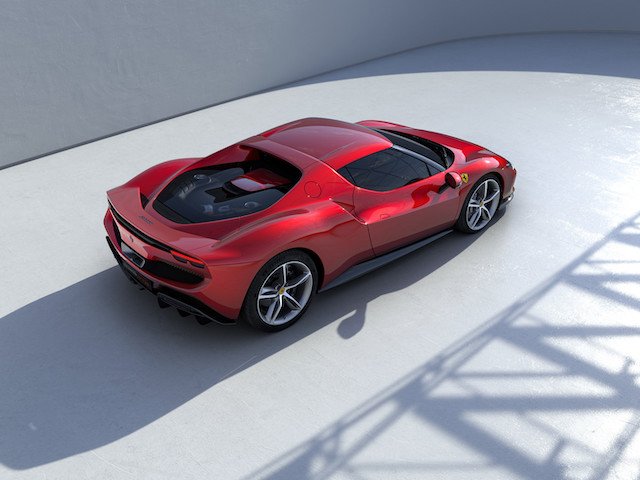By Peter M. DeLorenzo
Detroit. Yes, it was inevitable, I suppose. Ferrari, the most storied name in the automotive world and the maker of some of the most glorious high-performance machines ever created, is about to embark on a journey that will have hybrids and EVs making up 60 percent of its vehicle output by 2026.
I heartily disagree with this time frame, even though its new CEO, Benedetto Vigna, presented this strategy to investors and media types last week and insisted that it was so. That’s only four years from now, so as far as I’m concerned, it’s a giant “we’ll see” as we like to say around here. But the writing is definitely on the wall for the brand, as the halls of its headquarters in Maranello, which has been responsible for the creation of pure mechanical art for decades, will give way to such an inglorious endeavor as assembling battery modules.
The idea that Ferrari would give in to the prevailing winds is a reality that is being forced upon the legendary marque by burgeoning anti-ICE vehicle laws, which are spreading like wildfire in Europe. It could also be argued that Ferrari held on as long as possible before giving into the aforementioned inevitable, as other established brands have already embarked on their EV travels.
Porsche, for instance, has been peddling its Taycan since 2019, an overweight (5,200 lbs.) blunderbuss of a “sports car” with synthetic generated sound that does nothing for Porsche’s reputation from where I sit. In typical smug Porsche arrogance, the German manufacturer insists that it has it going on with the Taycan, and if you read between the countless media bites generated by Porsche PR minions and the dutiful fanboy reports in the automotive press, you would think that too. But make no mistake, the Taycan is a singularly unimpressive vehicle, one with about as much driving charm and appeal as a bloated, over-the-hill boxer with no fight left.
And now Ferrari is hell-bent on entering this world, because it is not only beholden to its shareholders, it finds itself in the throes of various European anti-car governments insisting that ICE vehicles be permanently banned from society. I can sympathize with Ferrari’s predicament, I really can. Because I would argue that no automobile manufacturer has more invested in the design, engineering and execution of automotive art than Ferrari. (Yes, Lamborghini has a tremendous history, too, but that’s for another column.) And even though Ferrari is succumbing to the mind-numbing hordes of Crossover/SUVs with its upcoming Purosange, in typical Ferrari fashion it will be powered by a classic V12, so it retains at least the essence of “Ferrari-ness.”
But 60 percent of the Ferrari product lineup eventually being hybrids or pure EVs? I can see the hybrid equation, because it makes eminent sense. But EVs? I can see where this is going already. Ferrari will continue its breathtaking design language – a feature that the Italian automaker has really stepped up of late - but its EVs will be devoid of the one critical feature that says Ferrari more than anything else: the sound. I don’t care how much the engineers at Ferrari work to create a synthetic sound signature worthy of the Ferrari name for its upcoming EVs – it will still be a synthetic sound signature. And to me, that spells trouble for Ferrari, as in, a giant pasta bowl of Not Good.
Ferrari is approaching a fork in the road, and while its overseers are confident that they can negotiate these fundamental changes while keeping its brand essence intact, I am not that optimistic. Ferrari has been a passionate endeavor since Day One. Enzo built and sold road machines to finance his racing, but that was a long, long time ago. The Italian auto manufacturer has managed to progress through the decades, and in terms of its most recent machines, we are witnessing a new heyday for Ferrari. Example? The new Ferrari 296GTB is one of the finest high-performance machines ever created, and it marks a glorious new chapter in the legend of Ferrari.
If Ferrari can maintain its essence building mandated synthetic sounding EVs to satisfy the demands of its various constituencies, while at the same time continuing to build fantastic ICE machines that make up 40 percent of its vehicle portfolio, it has a chance to survive with its legendary reputation intact. But that is a huge “if.”
I am not anti-EV by any stretch. In fact, moderately priced EVs make sense for urban use. But some EV applications just do not make sense. And this future path for Ferrari gives me serious pause, to say the least.
The automobile obviously means more to me than it does to most. I grew up immersed in this business, and the passionate endeavor surrounding the creation of automotive art has never stopped being interesting for me. And it is very much art, by the way. Emotionally involving and undeniably compelling mechanical art that not only takes us where we want to go but moves us in ways that touches our souls deeply.
As I’ve often reminded readers in this column, I for one will never forget the essence of the machine, and what makes it a living, breathing mechanical conduit of our hopes and dreams.
And in spite of this journey to the Dark Side, I hope the overlords at Ferrari never forget that.
And that’s the High-Octane Truth for this week.

(Ferrari images)
The 2022 Ferrari 296 GTB.



Editor's Note: You can access previous issues of AE by clicking on "Next 1 Entries" below. - WG